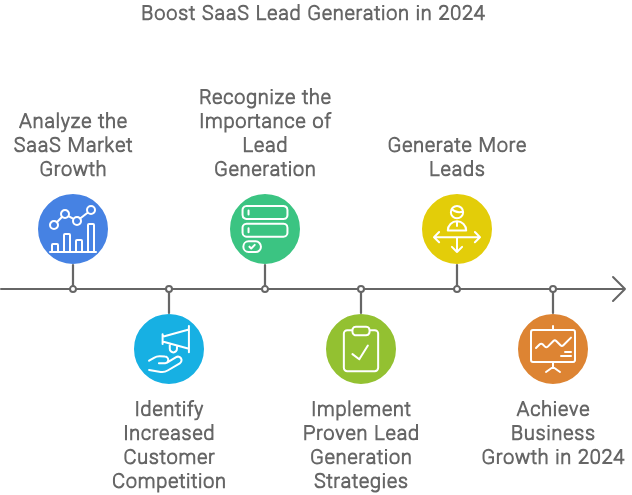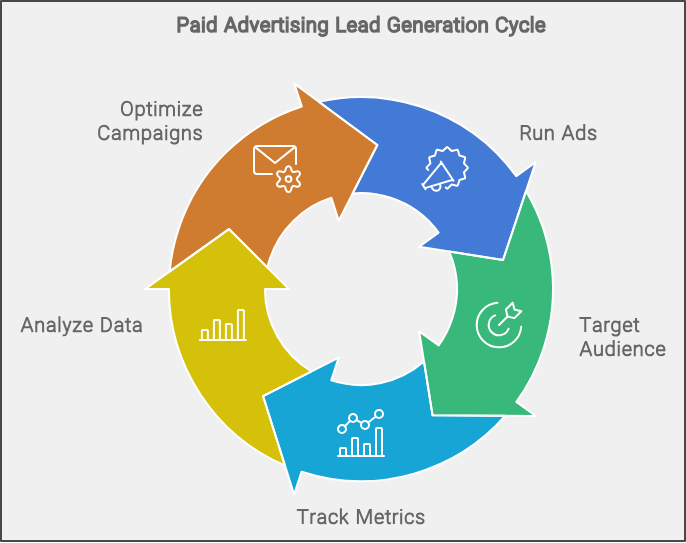12 Strategies to Generate Leads for SaaS Businesses in 2025

Regardless of where you stand in your SaaS journey, there are always fresh, untapped opportunities to boost SaaS lead generation for your business. The BVP Nasdaq Emerging Cloud Index underscores the rapid expansion of the SaaS market, with public SaaS companies seeing a growth rate of over 25% year-over-year.
This growth surge intensifies customer competition, underscoring the importance of effective lead-generation strategies. Seizing these opportunities is imperative, as acquiring new customers at a low cost is essential for sustaining business growth. So, where should you begin? Often, simple ideas yield the best results, and that’s where we come in.
Let’s discuss 12 strategies for SaaS lead generation that have been proven to work for SaaS b2b businesses. By taking advantage of these strategies, you’ll be well on your way to generating more leads and growing your business in 2025.

What is a Lead?
A lead is a potential customer who is identified as someone who could be interested in your product or service. Leads can be generated in various ways, but the most effective are those generated through targeted marketing efforts.

Leads can be generated through various methods, including online advertising, email marketing, and social media outreach. Partnering with email marketing companies can help streamline and optimize your campaigns, ensuring better engagement and higher conversion rates. By targeting potential customers and nurturing leads until they are ready to buy, you can dramatically increase your sales pipeline and grow your business.
What is SaaS Lead Generation?
SaaS lead generation involves the process of attracting and engaging potential customers who have an interest in your product. This process typically consists of:
Identifying Relevant Leads
Identifying relevant leads is crucial for effective b2b SaaS lead generation. This involves pinpointing potential customers most likely to benefit from your SaaS offering. To do this, it’s important to thoroughly understand your target market’s needs, pain points, and demographics. Conducting market research and creating detailed buyer personas can help identify these ideal prospects. By focusing on the right audience, you increase the chances of attracting leads who have a genuine interest in your product.
Engaging Qualified Leads
Establish connections with high-quality leads through various channels, such as cold emails, social media content, and case studies. Building trust and credibility is essential to nurturing these leads effectively. The goal is to establish connections with high-quality leads, build confidence, and demonstrate expertise. Providing valuable content and insights can help promote these leads effectively, moving them further down the sales funnel.
Driving Conversions
The primary objective is to convert engaged leads into paying customers. Techniques like webinars, product demos, and compelling offers help demonstrate the value of your SaaS solution and encourage leads to purchase or subscribe. Clear calls to action and seamless onboarding processes are also crucial in driving conversions.
Fostering Customer Retention
Lead generation doesn’t end with the conversion; retaining customers is equally important. Providing exceptional customer service, regular product updates, and loyalty programs are effective ways to maintain customer satisfaction. Ensuring that your customers continue to see value in your product fosters long-term relationships and encourages repeat business. Happy customers are also more likely to advocate for your brand, referring new leads and contributing to organic growth.
Why are Leads Important?
There are several reasons why leads are essential for businesses.
Foundation of Targeted Marketing
Leads serve as the foundation for targeted marketing efforts. Businesses can effectively tailor their advertising and marketing campaigns toward individuals most likely to be interested in their products or services by having a database of potential customers or clients. This targeted approach maximizes marketing efficiency and increases the likelihood of engagement and conversion. For instance, by analyzing lead data, businesses can segment their audience based on demographics, interests, and behaviors, creating personalized marketing messages that resonate more deeply with each segment. This personalization leads to higher engagement rates, as potential customers are more likely to respond to relevant content tailored to their needs and preferences.
Fueling Sales Growth
Leads are essential for driving sales growth. By nurturing leads and building strong relationships with potential customers, businesses can significantly enhance their chances of converting leads into actual sales. Effective lead nurturing strategies, such as personalized email campaigns, timely follow-ups, and providing valuable content, can improve lead conversion rates. Studies suggest that lead conversion rates can reach as high as 50% when leads are properly managed and nurtured. This highlights the significant impact that a well-managed lead generation process can have on a company’s sales performance. Furthermore, a consistent inflow of leads ensures a steady pipeline of potential customers, which is crucial for maintaining and scaling sales efforts over time.

Building Connections for Long-Term Business Success
Finally, even if a lead does not eventually result in a sale, it can still be valuable to your business. For example, if someone provides you with their contact information, you can add them to your email list and continue to market to them even if they don’t purchase immediately.
What are the Different Types of Leads?
There are two main types of leads: marketing-qualified leads (MQLs) and sales-qualified leads (SQLs).
Marketing Qualified Leads (MQL)
MQLs are leads identified as potential customers, but a sales representative has not yet contacted them. These leads are actively seeking solutions. Here are some indicators of marketing qualified leads:
- They engage by downloading your case studies.
- They show interest by watching videos about how your solutions work.
- They participate in webinars your company offers.
Given their interest in learning more about your solutions, converting them into prospects shouldn’t be overly challenging. You can complete the qualifying process through email or conversation. You can arrange a demo or presentation if you believe they are ready. However, not all of them will necessarily opt for your solution. It’s important to maintain persistence by following up with emails.
Sales Qualified Leads (SQL)
SQLs are leads contacted by a sales representative and are ready to be sold. These leads usually undergo a lead nurturing process to warm them up and interest them in your product or service. These leads should be considered highly promising, and you should contact them promptly. Because these leads are fully qualified, your task is simply to reach out, confirm their identity, and guide them through the sales process.
Your primary task with SQLs is to reach out to them, confirm their identity and interest, and then guide them through the final stages of the sales process. This might involve answering any remaining questions, addressing any concerns, and ultimately closing the deal. Because SQLs are already primed and ready to buy, your focus should be on providing exceptional service and facilitating a smooth transition from lead to customer.
How Can Businesses Make Sure They are Targeting the Right Leads?
Businesses can ensure they target the right leads in a few different ways.
First, it is crucial to understand your target market clearly. Knowing your ideal customer enables you to target your marketing efforts more effectively.
Secondly, consider using lead scoring to identify which leads are most likely to convert into customers. Lead scoring is a process by which you assign a point value to each lead based on demographics, interests, and behavior.

This can help you prioritize your sales efforts and spend your time on the leads most likely to convert.
How to Generate Leads for Your SaaS Business?
Now that we’ve discussed what leads are and why they’re essential, let’s look at how you can generate leads for your SaaS business. While there are many ways to generate leads, the 12 key SaaS lead generation strategies for SaaS businesses have been incredibly effective.
Create Compelling Content
Crafting engaging and valuable content is a powerful strategy for attracting and nurturing leads. It involves creating blog posts, eBooks, infographics, and other resources that offer helpful tips, advice, or insights relevant to your target audience.
When you provide potential customers with content that addresses their needs or challenges, you showcase your expertise and demonstrate your commitment to helping them succeed. This builds credibility and trust with your audience, making them more likely to engage with your brand and consider your offerings.
Furthermore, having a visually appealing and memorable logo can enhance your brand’s identity and make a lasting impression on potential customers. A well-designed logo communicates professionalism and reinforces your brand message, helping to differentiate your business from competitors.
In summary, creating compelling content and a captivating logo is essential for attracting and retaining leads. It enables you to establish authority in your industry, foster trust with your audience, and ultimately drive conversions and sales.
The survey findings on factors contributing to success in content marketing reveal several key insights. Nearly half of the respondents, 47%, prioritize audience research as a crucial element. Following closely behind, 46% emphasize the importance of search engine optimization (SEO) in their strategies. A significant portion, 45%, highlights the strategy of publishing more content and doing so more frequently as a key driver of success.
Use SEO to Boost Your Visibility
Another great way to generate leads is to use SEO to boost your visibility in search engines. By optimizing your website with relevant keywords, you can attract more visitors who are looking for what you have to offer, increasing the chances that these visitors will become leads.
When your website appears higher in search results for terms related to your business, it increases the likelihood of attracting visitors actively seeking products or services like yours. These visitors are already primed to be interested in what you offer, making them more likely to convert into leads.
SEO helps you connect with your target audience by ensuring that your website is easily discoverable when they’re searching for solutions that you provide. Partnering with a B2B SEO company can further enhance your strategy by optimizing your website for higher rankings, increasing organic traffic, and improving lead quality. This organic traffic boosts your website’s visibility and sets the stage for successful lead generation.
According to Ahrefs, 94.74% of keywords receive 10 or fewer monthly searches, indicating the vast majority of search queries are relatively low in volume.
Leverage Social Media
Another effective way to generate leads is by leveraging social media. Creating engaging content and building relationships with potential customers on social media can attract more leads and grow your business.
Social media platforms offer a dynamic landscape where businesses can engage with their target audience, share valuable content, and build meaningful relationships. Businesses can establish themselves as trusted authorities in their industry by creating compelling posts, sharing informative articles, and actively interacting with followers.
Moreover, social media provides a platform for businesses to showcase their products or services authentically and visually appealingly. Companies can showcase their offerings through visually striking images, captivating videos, and interactive stories and entice potential customers to learn more.
Social media also offers valuable insights into your target audience’s preferences, interests, and behaviors. By analyzing metrics such as engagement rates, click-through rates, and audience demographics, businesses can gain valuable insights into the effectiveness of their social media efforts and fine-tune their strategies accordingly.
Total spending on social media advertising is projected to soar to $219.8 billion in 2025, underscoring the growing importance and investment in this advertising channel.
Run Paid Advertising Campaigns
Paid advertising can also be an effective way to generate leads. By running ads on Google, Facebook, or other platforms, you can reach a wider audience with your message and attract more leads.
Paid advertising allows you to target specific demographics, interests, and behaviors precisely. Whether through compelling text ads on search engines or engaging multimedia ads on social media platforms, paid advertising offers businesses a versatile toolkit for connecting with potential leads and driving conversions.
You see metrics such as click-through rates, conversion rates, and cost per acquisition, gain actionable insights into the effectiveness of your ad campaigns, and make data-driven decisions to optimize performance. This iterative approach allows businesses to continuously refine their targeting, messaging, and creative elements to better resonate with their audience and generate high-quality leads.

Host Webinars or Live Events
Hosting webinars or live events is another excellent way to generate leads for SaaS businesses. These events allow you to provide valuable information to your audience and build relationships with potential customers. Additionally, you can offer something of value (like a coupon or discount) in exchange for contact information, which can be used to generate leads.
Businesses can capture leads and nurture relationships with potential customers by offering valuable content and engaging with attendees in real time.
The interactive nature of these events facilitates two-way communication, enabling businesses to address questions, concerns, and objections directly, thereby increasing the likelihood of conversion.
By offering valuable content and incentives, businesses can capture leads and cultivate relationships with potential customers, ultimately driving business growth and success.
Use Lead Magnets
A lead magnet is an incentive you offer in exchange for someone’s contact information. This could be a free eBook, a discount, or access to exclusive content. By offering a lead magnet, you can increase the chances that someone will provide their contact information, which can be used to generate leads.
The appeal of lead magnets lies in their ability to provide immediate value to the audience while simultaneously opening the door for further engagement. This exchange sets the stage for businesses to nurture leads through targeted marketing efforts and move them further down the sales funnel.
Leveraging lead magnets empowers businesses to attract, engage, and convert potential customers into leads effectively. By providing valuable incentives that resonate with their target audience, companies can initiate meaningful interactions, gather essential contact information, and lay the groundwork for long-term relationships and business growth.
Implement a Referral Program
Implementing a referral program is another excellent way to generate leads. You can attract more leads and grow your business by offering existing customers discounts or other incentives for referring new customers.
This organic form of promotion often carries more weight than traditional advertising, as recommendations from friends, colleagues, or clients are perceived as genuine endorsements. By empowering satisfied customers to become brand ambassadors, businesses can amplify their lead-generation efforts and foster a sense of community and loyalty among their customer base.
In summary, implementing a referral program presents businesses with a cost-effective and efficient lead-generation strategy. By capitalizing on the advocacy of existing customers and offering compelling referral incentives, companies can tap into a steady stream of high-quality leads, driving growth and success in the long run.
Collaborate with Other Businesses
Collaborating with other businesses is another effective way to generate leads. By partnering with complementary businesses, you can reach a wider audience and attract more leads.
Collaborative initiatives often involve offering joint promotions, co-hosting events, or cross-promoting each other’s products or services. These initiatives enhance brand visibility and create added value for customers. By offering incentives such as free trials or exclusive discounts as part of collaborative efforts, businesses can incentivize lead generation and encourage prospective customers to provide their contact information.
Collaborating with other businesses fosters synergistic relationships that drive lead generation and business growth. By leveraging shared audiences and offering compelling incentives, companies can expand their reach, attract more leads, and cultivate meaningful connections with potential customers. Collaborations amplify marketing efforts and create opportunities for innovation and differentiation in the competitive landscape.
Speak at Industry Events
Speaking at industry events is another excellent way to generate leads. These events allow you to share your knowledge with potential customers and position yourself as an expert in your industry. Industry events often attract attendees who are actively seeking solutions to their challenges or looking to stay informed about the latest trends and developments. By offering valuable content and actionable
In summary, speaking at industry events offers a multifaceted approach to lead generation. By leveraging speaking opportunities to share knowledge, connect with potential customers, and offer valuable incentives, businesses can effectively expand their reach, attract qualified leads, and lay the groundwork for long-term relationships and business growth.
Use Case Studies or Testimonials
Using case studies or testimonials is another effective way to generate leads. By sharing stories of how your product or service has helped other businesses, you can build trust with potential customers and increase their chances of becoming leads.
Case studies provide an in-depth look into specific use cases, demonstrating how your solution addresses common challenges or fulfills specific needs within a particular industry or context. On the other hand, testimonials offer concise endorsements from satisfied customers, highlighting the key benefits and outcomes they have experienced firsthand.
Moreover, sharing compelling case studies or testimonials across various marketing channels, such as your website, social media platforms, or email campaigns, amplifies their reach and impact. Businesses can effectively nurture leads and guide them toward making informed purchasing decisions by strategically leveraging these assets at different stages of the buyer’s journey.
Participate in Online Communities
Participating in online communities is another great way to generate leads. You can build relationships and attract more leads by engaging with potential customers in these communities.
It allows businesses to proactively engage with individuals actively seeking solutions to their problems or industry-related information. Companies can demonstrate their expertise and establish rapport with community members by providing helpful responses, addressing questions, and offering valuable resources. This engagement increases brand visibility and fosters a sense of trust and credibility, making community members more receptive to becoming leads.
Participating in online communities enables businesses to gain valuable insights into their target audience’s needs, preferences, and pain points. Companies can gather valuable intelligence that informs their lead-generation strategies and content-creation efforts by listening to conversations, monitoring discussions, and observing trends within these communities. Additionally, businesses can identify opportunities to address specific challenges or gaps in the market, positioning themselves as solutions providers and attracting qualified leads.
By actively engaging with potential customers, providing valuable insights, and listening to their needs, businesses can build relationships, establish credibility, and drive lead generation in today’s digital landscape.
Stay In Touch With Past Customers
Staying in touch with past customers is another effective way to generate leads. By keeping in touch with your past customers, you can stay at the top of your mind and increase their chances of becoming leads again.
Using b2b SaaS lead-generation strategies can attract more leads and grow your SaaS business. What’s important is that you find what works best for your business and implement a plan to help you achieve your goals.
Conclusion
Generating leads is essential for any SaaS business. The key to success lies in finding what works best for your business and implementing a plan to help you achieve your goals. By taking advantage of these 12 strategies, you can attract more leads and grow your business.



